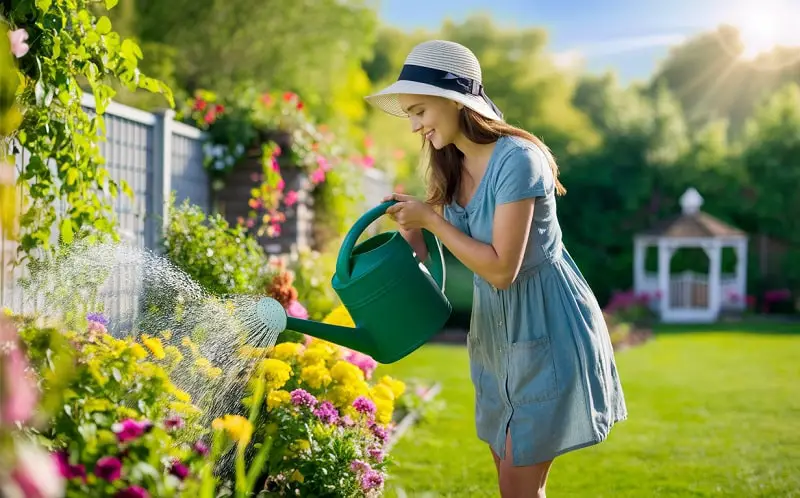If you’re new to gardening, you may be surprised to learn that watering your plants isn’t as simple as just grabbing a hose and dousing your garden. Proper watering techniques are crucial for ensuring healthy growth and vibrant plants.
In this comprehensive guide, we’ll dive into the essential watering tips every beginner gardener needs to know. With the right approach, you’ll avoid common pitfalls and create a thriving garden.
1. Understanding Your Garden’s Needs
Before you start watering, it’s important to understand that not all plants have the same water requirements. Some plants thrive in dry conditions, while others need consistently moist soil. Researching the water needs of the specific plants in your garden is the first step to getting watering right.
Factors That Influence Watering Needs
- Plant Type: Succulents need far less water than leafy vegetables.
- Soil Type: Sandy soils drain quickly, while clay soils retain water longer.
- Climate and Season: Hot, dry weather increases the need for water, while cooler temperatures reduce it.
Knowing these factors will help you determine the optimal watering schedule for your garden.
2. The Best Time to Water Your Plants
Timing matters when it comes to watering. The early morning hours are generally the best time to water your garden. Why? The cooler temperatures allow water to soak into the soil before the sun’s heat causes rapid evaporation. Watering in the evening is another option, but it can lead to excess moisture, which promotes fungal growth. Morning watering strikes the right balance, keeping your plants hydrated without encouraging disease.
3. How Often Should You Water?
One of the most common questions beginner gardeners ask is how frequently they should water. Unfortunately, there isn’t a one-size-fits-all answer. Instead, focus on deep, infrequent watering rather than shallow, frequent watering. Deep watering encourages roots to grow deeper into the soil, making plants more resilient to drought.
- For most gardens, watering once or twice a week is sufficient.
- During hot spells, you may need to increase the frequency.
- Use the finger test: Insert your finger about 2 inches into the soil. If it’s dry, it’s time to water.
4. How Much Water is Enough?
The amount of water your garden needs depends on various factors, but as a rule of thumb, aim for about 1 inch of water per week. You can measure this by placing a rain gauge or a shallow container in your garden. Overwatering can be just as harmful as underwatering, so be cautious. Plants with yellowing leaves or soggy soil may be suffering from too much water.
5. Watering Techniques: Which Method is Best?
Different gardens require different watering methods. Here are a few popular techniques to consider:
Hand Watering
Hand watering with a hose is common for small gardens or specific plants that need extra attention. Use a watering can or hose with a gentle nozzle to avoid damaging delicate plants.
Soaker Hoses and Drip Irrigation
For larger gardens or water-sensitive plants, consider using soaker hoses or drip irrigation systems. These methods deliver water directly to the roots, minimizing evaporation and keeping leaves dry.
Sprinklers
Sprinklers cover a wide area but can lead to excess water loss through evaporation. They’re best suited for lawns or larger garden spaces where precision is less important.
6. Avoiding Common Watering Mistakes
Even with the best intentions, beginner gardeners often make some common watering mistakes. Here’s how to avoid them:
- Overwatering: More water doesn’t mean healthier plants. Overwatering can lead to root rot and nutrient loss.
- Watering Leaves Instead of Roots: Focus on watering the soil, not the leaves. Wet leaves are more prone to disease.
- Ignoring Soil Drainage: If water sits on the surface, your soil may be compacted or have poor drainage. Amend the soil with organic matter to improve it.
7. Watering Different Types of Plants
Different plants have different watering needs. Here are a few tips for some common garden plants:
- Vegetables: Most vegetables require consistent moisture, especially when flowering and fruiting.
- Flowering Plants: Flowering plants like roses and hydrangeas often need more water than others. Water at the base to prevent fungal issues.
- Succulents and Cacti: These drought-tolerant plants need infrequent watering, typically once every two weeks.
8. Signs Your Plants Need Water
Learning to recognize when your plants are thirsty is key to a healthy garden. Look for these signs:
- Wilting: If leaves are drooping or curling, your plants may need water.
- Dry Soil: As mentioned earlier, check the soil’s moisture level.
- Slow Growth: Plants that aren’t getting enough water may show stunted growth.
9. Watering During Different Seasons
Watering needs change with the seasons. In spring and summer, plants are actively growing and need more water. During fall and winter, when growth slows, you can reduce watering. Always adjust your watering schedule based on the time of year.
10. Sustainable Watering Practices
As a gardener, it’s important to consider sustainability. Here are some eco-friendly watering tips:
- Collect Rainwater: Use rain barrels to collect and store rainwater for your garden.
- Mulching: Mulch helps retain soil moisture, reducing the need for frequent watering.
- Group Plants by Water Needs: Place plants with similar water requirements together to minimize waste.
Conclusion
Watering your garden may seem simple, but doing it correctly requires some know-how. By understanding your garden’s needs, timing your watering, and using the right techniques, you can help your plants thrive. Remember, a well-watered garden is a healthy garden. With these essential watering tips, you’ll be well on your way to becoming a successful gardener.
